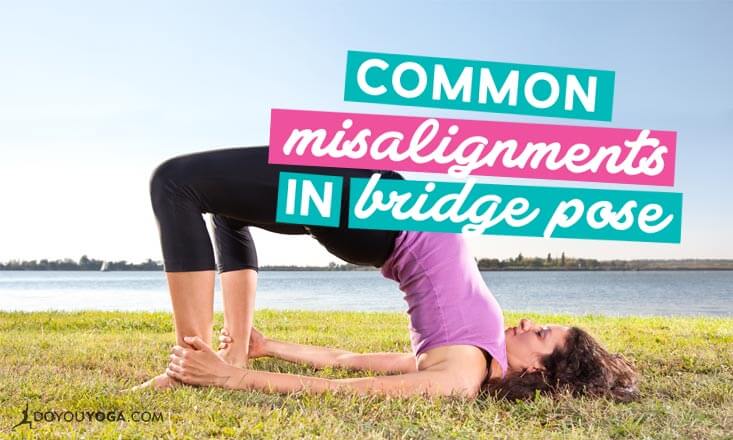At first glance, Bridge Pose doesn’t seem very elaborate, but when you get down to it, it is one of those rich postures filled with goodness! A strengthening posture that increases flexibility, focus, and breath control, it's like your entire yoga practice in one neat little package.
What's more, is that the more accurately you line up your Bridge Pose, the more scrumptious in can be.
Starting slow and deepening this posture can encourage an entire range of heart opening benefits and spinal flexibility. Bridge Pose even strengthens the hamstrings and pelvis, but only if it is done with proper alignment
In any form of back bending, it is vital that you listen to how your body is aligned to make sure that you are safe and supported in your lift, and that you are getting all the benefits of the frontal opener as well as the spinal bend.
Here are the most common misalignments in Bridge Pose and a few quick fixes:
1. Head
Your chin being squashed up next to your chest is, surprisingly, the most common misalignment in Bridge Pose. Make sure there is space between your chin and your chest throughout your hold. This keeps your neck relaxed and your airways clear.
Also, make sure not to move your head while you're in Bridge Pose, as this can cause neck injury. Keep still and relaxed, and you'll be good to go.
2. Feet Placement
Your feet should be hip-width distance apart so that your knees can stack over your ankles for support.
Often people overestimate how wide their hips are or hold their feet together. This will result in a wobbly base, so I suggest starting in a seated position and placing your feet the same width as your hips from there. Then come to lie on your back, and lift into Bridge Pose. Voila! Your feet are aligned.
3. Hip Rotation
Many people find their knees either turn outwards in this pose, or that their knees knock inwards. This is a matter of stability in the pelvis, which is what is holding you up, so let’s keep it strong!
Knees falling out means your hips are exteriorly rotated. Knees knocking means your hips are too far internally rotated. If your feet are directly under your knees (as in the previous correction) then all you have to do is hold your feet parallel or slightly turn your toes in, heels out to make sure your hips are lined up.
4. Thigh Squeeze
With the correct foot placement, your thighs should be squeezing in as if trying to hold a block between your knees. This, again, lends to better support in the pelvis.
Try actually holding a block there to produce this sensation (it will actually help strengthen your hamstrings, also). Your Bridge Pose will immediately feel stronger and more supported!
5. Unsupportive Shoulders
Your shoulders need to be scooped completely underneath you so that you are resting on the edges of your arms and your chest protrudes up. Otherwise, your Bridge doesn't have the full support it needs to keep standing.
If this is challenging, you could try holding on to the edges of your mat and pulling. Think about your shoulder blades coming together underneath you.
6. Wrists
In the variation of bridge with your hands interlaced underneath you, many people have a tendency to hold their grasp with their wrists at 90 degrees, putting unnecessary strain on the wrists.
Instead, protect your wrists and encourage a deeper arm stretch by pressing your palms together as much as possible.
So there it is. A healthy, happy Bridge Pose for you to utilize forever more!
How do you keep your Bridge Pose from falling down? Do you have any alignment tips to share with the community? Then leave a comment below!


